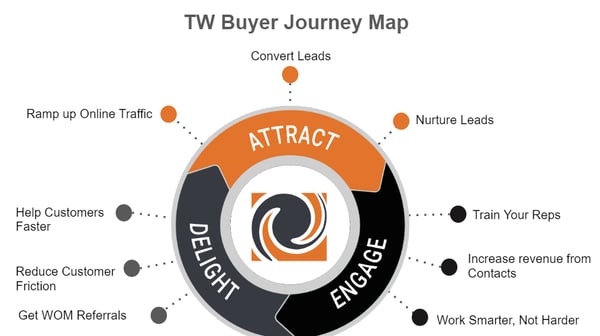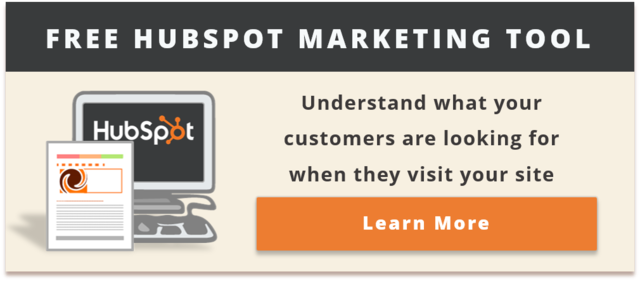SHARE
How to Drive Growth to Your Business With HubSpot's Flywheel

What is HubSpot’s Flywheel?
HubSpot’s flywheel is a long-term business model that places value on your relationships. It drives your company growth by attracting prospects with problems that need to be solved via your relevant content. Then, you engage with them on their own terms and form long-lasting, meaningful relationships. By providing a remarkable experience throughout, your happy customers will drive referrals and bring more sales to your business to help it grow and create momentum that keeps your business spinning. It’s a win-win situation.
How does it do this? HubSpot’s flywheel uses the inbound methodology to help grow your business.
- First, you attract visitors with relevant content,
- Then, engage prospects by nurturing the relationship,
- And finally, delight customers by ensuring they enjoy their buyer journey experience.
When prospects become happy customers, they will refer their friends, leave positive reviews, and promote your brand.
Your customers are the main source of energy that helps accelerate the growth of your business. Therefore the flywheel is a great model to use because it builds momentum that keeps your business spinning by focusing on your customers who will drive more sales.
To drive momentum to your flywheel, you need to increase its speed because the faster it spins, the better the business grows. In each phase of the wheel, look into areas that will provide the greatest impact of growth to your business, and apply “forces” by creating and adjusting to better strategies and programs.
The strategies and programs you can leverage throughout the buyer’s journey include:
- Inbound marketing
- Customer referral program
- Paid advertising
- Investing in your customer service team
To ensure nothing slows down your flywheel, reduce “friction” from your business strategy. So think about where your customers might lose momentum throughout the phases of the flywheel.
Some problems that may come up throughout the buyer’s journey include:
- The complicated signup process for your leads
- Inadequate training for customers to get the most out of your product
- Opposing goals and lack of communication between teams within the company
- Misalignment between customers and employees
For the company to be successful, it needs to adjust its business strategy to adapt to the above factors.
Let’s break it down further using an example from Tangible Word’s Buyer Journey Map below.The 3 Phases to Hubspot’s Flywheel:
- Attract
- Engage
- Delight

In the first phase, the goal is to attract leads with useful content as they learn about the company. Ramp up online traffic and apply forces such as content marketing and targeted paid ads to convert your leads. Then nurture your leads so they gain your trust and become prospects.
The focus is to nurture the relationships with your prospects by enabling them to engage with you on their own time and choice of channel. Work smarter, not harder, by training the representatives on your team to provide support and answer questions for your prospects quickly and professionally. Implementing strategies such as blog posts, sales automation, and persona-based email marketing can help your business increase revenue from your prospects later on.
Customer success is the final phase of the flywheel. Help, support, and empower your customers quickly to solve their problems. Remember - how you treat your customers will affect what prospects hear about you because that’s how people make decisions today. Your prospects will take into account word-of-mouth referrals from their network as well as the company’s brand on social media and reviews on other sites. Some strategies you can leverage in this phase include customer service, customer feedback surveys, and loyalty programs.
HubSpot is a great platform that provides you with various tools for the inbound methodology of the flywheel. Their tools include the ability to track individuals from their first visit, combining customer relationship management (CRM), marketing automation, and service management all in one platform.
Focus on your customers who will then be loyal to your brand and in turn build growth for your business.
Start Using HubSpot Today & Grow Your Business with HubSpot’s Flywheel!
References:
Topics
- Content Creation (297)
- Growth-Driven Design Websites (167)
- Inbound Marketing (146)
- Sales Growth (133)
- Tangible Words (111)
- Search Engine Optimization (85)
- Social Media Marketing (83)
- Hubspot (76)
- Blogging for Business (75)
- Economic Development (64)
- Events & Training (60)
- Company Growth Podcast (49)
- Manufacturing (47)
- Tourism (46)
- Email Marketing (42)
- Case Stories (40)
- Testimonials & Client Feedback (36)
- Education and SaaS (23)
- Google (21)
- Careers (19)
- Inbound Marketing Agency (19)
- Cool Companies (18)
- FAQ (16)
- Alysha Dominico (13)
- Associations (7)
- Food and Beverage (7)
TW Blog Sign-Up
Learn more about how to grow your business and improve your sales team process.







